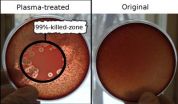Heart disease, stroke deaths continue to fall but costs remain high
American Heart Association year-end report
2010-12-16
(Press-News.org) America is winning a battle against heart disease and stroke mortality, but is still losing the war, according to the American Heart Association.
In Heart Disease and Stroke Statistics – 2011, published online in Circulation: Journal of the American Heart Association, the association reports that the death rate from heart diseases declined 27.8 percent from 1997 to 2007 (the most recent final data available), and the stroke death rate fell 44.8 percent.
However, during the same period, the total number of inpatient cardiovascular operations and procedures increased 27 percent. The estimated total cost from heart disease and stroke in the United States for 2007 (including health expenditures and lost productivity) was $286 billion. That's higher than any other diagnostic group. In 2008, the estimated cost of all cancer and benign tumors was $228 billion, according to the update.
The trend calls for not only tracking disease, but tracking risk factors and what it takes to remain free of heart disease and stroke, said Véronique L Roger, M.D., M.P.H., lead writer of the report.
"The mortality rate going down is good news; however, the fact that the burden of disease is so high indicates that we may have won a battle against mortality but have not won the war against heart disease and stroke," said Roger, professor of medicine and epidemiology at the Mayo Clinic College of Medicine and chair of health sciences research at the Mayo Clinic in Rochester, Minn. Heart disease and stroke remain among the leading killers of Americans, together accounting for one in every three deaths each year.
"We're seeing a decline in deaths for both, particularly for stroke," Roger said. "We can attribute much of that to improved quality of care, with heart and stroke patients getting the care and treatment they need to live longer. But unfortunately the prevalence of these diseases and their risk factors are still high. We need to energize our commitment to strategies that can prevent disease in the first place."
Of heart disease and stroke risk factors, according to the American Heart Association statistics:
33.5 percent of adults 20 years and older in America have high blood pressure; 80 percent are aware of their condition but less than half have their condition under control.
23.1 percent of men and 18.1 percent of women are cigarette smokers; 19.5 percent of students in grades 9 through 12 report current tobacco use.
15 percent of adults 20 and older have total serum cholesterol levels of 240 mg/dL or higher.
8 percent of adults have been diagnosed with diabetes mellitus; 36.8 percent have prediabetes.
More than 67 percent of adults are overweight.
During the past 30 years, the prevalence of obesity in children 6 to 11 years has increased from about 4 percent to more than 20 percent.
In future updates, the American Heart Association will track progress toward its 2020 Impact Goal: to improve the cardiovascular health of all Americans by 20 percent while reducing deaths from cardiovascular diseases and stroke by 20 percent.
"Our baseline data related to the 2020 goal in the new update indicate the need for substantial progress in order to meet those goals in the next decade," Roger said. "To achieve improvements in cardiovascular health, all segments of the population will need to focus on improved cardiovascular health behaviors, particularly with regard to diet and weight, as well as increasing physical activity and further reducing the prevalence of smoking."
The new version of the statistical update is the first to include a chapter detailing how family history and genetics play a role in cardiovascular disease risk.
According to the update:
Parental history of an early heart attack doubles the risk of a heart attack in men and increases the risk in women by about 70 percent.
Sibling history of heart disease doubles the odds of heart disease in both men and women.
"We make the point in the update that the increased risk of heart disease seen in persons with a family history of a heart attack is likely due in part to shared genetics," Roger said. "The role of genetic factors in the risk of cardiovascular disease will likely be a growing part of the report in the future."
INFORMATION:
Additional resources:
Each year, the American Heart Association, along with the Centers for Disease Control and Prevention, National Institutes of Health, and other government agencies, collect the most up-to-date statistics on heart disease, stroke, other vascular diseases, and their risk factors and presents them in its Heart Disease and Stroke Statistics. For the most recent statistical update, go to: http://circ.ahajournals.org/cgi/reprint/CIR.0b013e3182009701
In January 2010, the American Heart Association embarked on a bold new approach to reducing cardiovascular disease by establishing the 2020 Impact Goals. Learn more and see the full paper at http://circ.ahajournals.org/cgi/content/full/121/4/586.
The 2020 Impact Goals include a novel concept of defining cardiovascular health which encompasses seven health behaviors and health factors that impact heart health. To learn more about Life's Simple 7 and to find your heart health score, visit www.heart.org/mylifecheck.
Downloadable stock footage, animation and our image gallery are located at www.heart.org/news under Multimedia.
ELSE PRESS RELEASES FROM THIS DATE:
2010-12-16
Body fat distribution does not play an important role in the incidence of every subtype of premenopausal breast cancer, but is associated with an increased risk for estrogen receptor (ER)–negative breast cancer, according to a study published December 15 in The Journal of the National Cancer Institute.
Previous studies have shown that the association between body mass index (BMI) and the risk of breast cancer varies with menopausal status: a higher BMI is positively associated with risk of postmenopausal breast cancer but inversely associated with risk of premenopausal ...
2010-12-16
"Staph" bacteria feed on blood. They need the iron that's hidden away inside red blood cells to grow and cause infections. It turns out that these microbial vampires prefer the taste of human blood, Vanderbilt University scientists have discovered.
The researchers report in the Dec. 16 issue of Cell Host & Microbe that Staphylococcus aureus (staph) favors human hemoglobin – the oxygen-carrying protein that contains iron – over hemoglobin from other animals. The findings help explain why staph preferentially infects people and suggest that genetic variations in hemoglobin ...
2010-12-16
STANFORD, Calif. — More than 2,000 genetic regions involved in early human development have been identified by researchers at the Stanford University School of Medicine. The regions, called enhancers, are responsible for triggering the expression of distant genes when embryonic stem cells begin to divide to form the many tissues of a growing embryo.
"This is going to be an enormous resource for researchers interested in tracking cells involved in early human development," said Joanna Wysocka, PhD, assistant professor of developmental biology and of chemical and systems ...
2010-12-16
LA JOLLA, CA-In addition to fast food, desk jobs, and inertia, there is one more thing to blame for unwanted pounds-our genome, which has apparently not caught up with the fact that we no longer live in the Stone Age.
That is one conclusion drawn by researchers at the Salk Institute for Biological Studies, who recently showed that mice lacking a gene regulating energy balance are protected from weight gain, even on a high fat diet. These findings have implications for the worldwide obesity epidemic and its consequences, such as type two diabetes.
In the December 16, ...
2010-12-16
The software tool presents data visually and this allows those without specialist training – both professionals and older people – to better understand and contribute to discussions about the mechanics of movement, known as biomechanics, when carrying out everyday activities.
The software takes motion capture data and muscle strength measurements from older people undertaking everyday activities. The software then generates a 3D animated human stick figure on which the biomechanical demands of the activities are represented visually at the joints. These demands, or stresses, ...
2010-12-16
A newly published insight into the biology of many kinds of less-aggressive but still lethal brain tumors, or gliomas, opens up a wide array of possibilities for new therapies, according to scientists at Brown University and the University of California, San Francisco (UCSF). In paper published online Dec. 15 in the Journal of the National Cancer Institute, they describe how a genetic mutation leads to an abnormal metabolic process in the tumors that could be targeted by drug makers.
"What this tells you is that there are some forms of tumors with a fundamentally altered ...
2010-12-16
Richmond, Va. (Dec. 15, 2010) – Researchers at Virginia Commonwealth University Massey Cancer Center and the VCU Institute of Molecular Medicine (VIMM) have developed a novel virus-based gene therapy for renal cell carcinoma that has been shown to kill cancer cells not only at the primary tumor site but also in distant tumors not directly infected by the virus. Renal cell carcinoma is the most common form of kidney cancer in adults and currently there is no effective treatment for the disease once it has spread outside of the kidney.
The study, published in the journal ...
2010-12-16
Absence makes your heart grow fonder, but close-quarters may boost your career.
According to new research by scientists at Harvard Medical School, the physical proximity of researchers, especially between the first and last author on published papers, strongly correlates with the impact of their work.
"Despite all of the profound advances in information technology, such as video conferencing, we found that physical proximity still matters for research productivity and impact," says Isaac Kohane, the Lawrence J. Henderson Professor of Pediatrics at Children's Hospital ...
2010-12-16
A small-scale University of California, San Francisco-led study has identified the first evidence in humans that exposure to bisphenol A (BPA) may compromise the quality of a woman's eggs retrieved for in vitro fertilization (IVF). As blood levels of BPA in the women studied doubled, the percentage of eggs that fertilized normally declined by 50 percent, according to the research team.
The chemical BPA, which makes plastic hard and clear, has been used in many consumer products such as reusable water bottles. It also is found in epoxy resins, which form a protective ...
2010-12-16
Cold plasma jets could be a safe, effective alternative to antibiotics to treat multi-drug resistant infections, says a study published this week in the January issue of the Journal of Medical Microbiology.
The team of Russian and German researchers showed that a ten-minute treatment with low-temperature plasma was not only able to kill drug-resistant bacteria causing wound infections in rats but also increased the rate of wound healing. The findings suggest that cold plasmas might be a promising method to treat chronic wound infections where other approaches fail.
The ...
LAST 30 PRESS RELEASES:
[Press-News.org] Heart disease, stroke deaths continue to fall but costs remain high
American Heart Association year-end report


